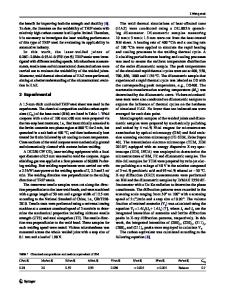Fiber Laser Welded AZ31 Magnesium Alloy: The Effect of Welding Speed on Microstructure and Mechanical Properties
- PDF / 1,813,348 Bytes
- 15 Pages / 593.972 x 792 pts Page_size
- 26 Downloads / 369 Views
ODUCTION
TODAY, decreasing weight in ground vehicles and aircraft is considered one of the most effective approaches to improve fuel economy and reduce anthropogenic environment-damaging emissions.[1–4] The development and application of magnesium (Mg) alloys, being the lightest structural metallic materials, have thus attracted considerable interest in the automotive and aerospace industries in recent years because of their light weight and good mechanical properties.[1,5–8] The structural applications of Mg alloys inescapably involve an important manufacturing process—welding. Some processing problems and welding defects such as oxide films, crack, and porosity could easily be caused by the physical properties of Mg, such as its strong tendency to oxidize, high thermal conductivity, low melting and boiling temperatures, high solidification shrinkage, and tendency to form low melting point constituents, low viscosity, and high solubility for hydrogen in the liquid state.[9] Weisheit et al.[10] performed CO2 laser welding of different Mg alloys and showed that most Mg alloys can be easily welded without serious defects, except AZ series and AM series, S.H. CHOWDHURY, Graduate Student, D.L. CHEN, Professor and Ryerson Research Chair, and S.D. BHOLE, Professor, are with the Department of Mechanical and Industrial Engineering, Ryerson University, Toronto, ON M5B 2K3, Canada. Contact e-mail: [email protected] E. POWIDAJKO, Graduate Student, D.C. WECKMAN, Professor, and Y. ZHOU, Professor and Canada Research Chair, are with the Department of Mechanical and Mechatronics Engineering, University of Waterloo, Waterloo, ON N2L 3G1, Canada. Manuscript submitted June 7, 2011. Article published online January 5, 2012 METALLURGICAL AND MATERIALS TRANSACTIONS A
which exhibited extremely high levels of porosity. Zhao and Debroy[11] investigated the formation of porosity in an AM60 Mg alloy during laser welding and concluded that hydrogen in the parent material was the main origin of porosity in the welds. Sun et al.[12] evaluated TIG, CO2, and pulsed Nd:YAG laser welded joints of AZ31 sheet and reported that TIG welding could be used to achieve welds without defects, but noted that coarser grain sizes in TIG welds could diminish the mechanical properties. Recently, among the several types of lasers, attention has been paid to fiber lasers, because this type of laser presents several benefits for industrial applications, namely high power with low beam divergence, flexible beam delivery, low maintenance costs, high efficiency of laser generation, and compact size of laser apparatus.[13] After fiber laser welding (FLW), microstructural changes occurred across the welded joint including local variations of grain sizes in the fusion zone (FZ) and heat-affected zone (HAZ), grain shape and orientation, and formation of porosity. These microstructural changes could affect the mechanical properties such as tensile and fatigue strength, and strain-hardening behavior, as well as potentially compromise the integrity and longevity of the welded joints and
Data Loading...











